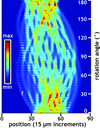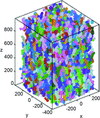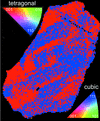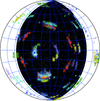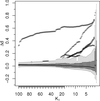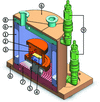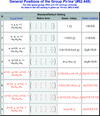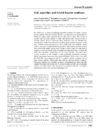issue contents
December 2012 issue

Cover illustration: Example of a three-dimensional reciprocal-space map recorded from a sample of GaAs nanowires grown on GaAs. Courtesy of Schlepütz et al. [J. Appl. Cryst. (2011), 44, 73-83].
research papers
The microstructure of an SiC-monofilament-reinforced Al matrix is reconstructed with 15 µm in-plane volume elements using microcomputed tomography based on diffracted intensities from SiC and Al phases.
Three-dimensional X-ray diffraction microscopy is a fast and nondestructive structural characterization technique aimed at studies of the individual crystalline elements (grains or subgrains) within millimetre-sized polycrystalline specimens. A review of the field is provided, with a viewpoint from materials science.
The evolution of the crystallographic orientation field in a polycrystalline sample of copper is mapped in three dimensions as tensile strain is applied. Using forward-modeling analysis of high-energy X-ray diffraction microscopy data, the ability to track intragranular orientation variations is demonstrated.
Combining diffraction/scattering and tomography methods allows the three-dimensional structural imaging of heterogeneous samples to discriminate multiple crystalline and amorphous materials. The principle and applications of the methods are described and the reconstruction artefacts and limitations are discussed.
The input parameters for the powder charge-flipping algorithm in the program Superflip have been optimized by considering one inorganic and one organic case.
The capability of electron backscatter diffraction to recognize and to quantify tetragonal lattice distortion is illustrated on the example of zirconia partially stabilized by magnesium. The combination of electron backscatter diffraction and X-ray diffraction is shown to be a suitable method for local and quantitative phase analyses in materials with composition gradients on the sub-micrometre scale.
An inversion method for obtaining intragranular lattice orientation distributions as well as orientation-dependent lattice strains is developed and applied to high-energy X-ray diffraction data regarding the α → ∊ phase transition in iron.
A new cassette system for protein cryocrystallography has been developed. This system is compatible with crystal-exchange robots installed at both SPring-8 and the Photon Factory.
A general approach is proposed for the computation of the common volume function and of the corresponding X-ray powder diffraction line profile for polyhedral particles.
An optimized data collection strategy for adaptively refined successive X-ray pole figure measurements is presented. Numerical results of a travelling salesman problem minimizing the measurement time of highly irregular pole figure measurement grids are compared.
The thermophysical properties of Nd3+-doped La2CaB10O19 crystals were fully analyzed along the a, b, c, c*, a*, 〈110〉 and 〈110〉* crystalline directions. The calculated Jackson factors of a series of observed faces on the crystal show that the liquid–solid interface is a smooth surface when the crystal grows from solution.
Download citation


Download citation


A new restraint scheme based on Morse bond potential is introduced. A statistical analysis of bond lengths refined with these restraints is demonstrated to be useful for detection of wrong Rietveld refined structures.
Download citation


Download citation


A new structure is proposed for sulfuric acid octahydrate. The structure and thermal expansion behaviour were determined using synchrotron powder diffraction methods.
A methodology is presented for extracting the thickness and length of plate-like precipitates from streaking that appears in the small-angle scattering patterns of moderately textured polycrystalline samples.
A procedure to use time-of-flight neutron diffraction at the Spallation Neutron Source to exploit structures of aligned stacks of lipid bilayers is reported. The method was verified by two well known lipid bilayers and then applied to elucidate the impact imparted by the antimicrobial peptide alamethicin on membranes with and without cholesterol.
A first-generation-synchrotron-class X-ray laboratory microsource, in combination with a new restoration algorithm, was used to probe nanoscale-assembled superstructures with grazing-incidence small-angle X-ray scattering. The proposed algorithm allows the virtual enhancement of the instrument brilliance, improving signal-to-noise ratio and fringe visibility and reaching performances comparable to third-generation synchrotron radiation beamlines.
MAGNEXT is a new computer program available from the Bilbao Crystallographic Server (https://www.cryst.ehu.es) that provides symmetry-forced systematic absences or extinction rules of magnetic nonpolarized neutron diffraction.
The elastic deformation produced by the cylindrical bending in a bent perfect crystal can enormously strengthen the multiple Bragg reflection effects, which can then be investigated even at small neutron sources.
Special directions in the Brillouin zone for hexagonal, tetragonal and trigonal lattices are defined. They optimize a description of various physical quantities having full symmetry of the Brillouin zone, and they define the projections, measured either in Compton scattering or in positron annihilation experiments, that allow reconstruction of electron momentum densities with the highest efficiency.
A sample environment that enables in situ X-ray studies of battery materials during electrochemical cycling is presented.
The new direct-space strategy TALP for ab initio crystal structure determination, consisting of a sophisticated search algorithm coupled to fast restrained least-squares refinements, is described and tested on laboratory X-ray powder diffraction data of 14 molecular compounds.
A new method for analysis of scattering data from lamellar bilayer systems is presented. The method employs a form-free description of the cross-section structure of the bilayer and the fit is performed directly to the scattering data, introducing also a structure factor when required.
The VLD (vive la difference) phasing algorithm is combined with hybrid Fourier syntheses to solve ab initio small and medium-size structures and proteins.
A supercell structural model is calibrated with the PONKCS (partial or no known crystal structure) method to quantify turbostratically disordered nontronite in laterite ores using synchrotron diffraction data.
A new position-factor method is proposed to calculate the interplanar spacing of a crystal.
On the basis of diffuse scattering analysis, the structure of lead-based relaxors is shown to correspond to the specific dipole glassy state, as opposed to the concept of polar nanoregions.
short communications
A recent paper has proposed a revised version of the Lorch modification function used to Fourier transform radiation total scattering data. The present paper compares the results of using the revised function with those from using the original Lorch function.
A Bonse–Hart-type ultra-small-angle X-ray scattering instrument, exploiting Si(440) crystal optics using higher than 20 keV X-rays, is under development. This instrument has a q resolution of ∼2 × 10−5 Å−1 and scattering vector range from 2 × 10−5 to 1.8 Å−1 and shows promise for future operations.
computer programs
The web-based program PASCal (https://pascal.chem.ox.ac.uk) is introduced as a tool for determining principal coefficients of thermal expansion and compressibilities using variable-pressure and variable-temperature lattice parameter data. The additional scientific insight provided by this analysis is illustrated with reference to three case studies: the metal–organic framework Cu-SIP-3, the molecular crystal β-HMX and the mineral malayaite.
laboratory notes
Open  access
access
 access
accessA simple robust manual protocol for producing crystals in the lipidic cubic phase in less than an hour is described. It is designed to provide newcomers to the in meso method for crystallizing membrane proteins with experience of preparing, handling and growing crystals in the sticky and viscous lipidic mesophase.


 journal menu
journal menu








